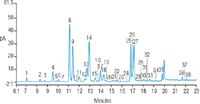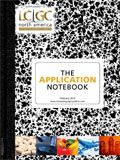Quantitation of Omega Fatty Acids by HPLC and Charged Aerosol Detection
Omega-3 and -6 fatty acids are essential compounds required for normal growth. Omega-3 consumption is purported to have a number of health benefits, e.g., cancer prevention, cardiovascular disease prevention, and improved immune function. Although both omega-3 and -6 fatty acids can give rise to eicosanoid-signaling molecules (prostaglandins, prostacyclins, thromboxanes, and leukotrienes), the omega-6 eicosanoids are generally proinflammatory. A person's diet requires a balance of omega fatty acids at suitable levels.
Omega-3 and -6 fatty acids are essential compounds required for normal growth. Omega-3 consumption is purported to have a number of health benefits, e.g., cancer prevention, cardiovascular disease prevention, and improved immune function. Although both omega-3 and -6 fatty acids can give rise to eicosanoid-signaling molecules (prostaglandins, prostacyclins, thromboxanes, and leukotrienes), the omega-6 eicosanoids are generally proinflammatory. A person's diet requires a balance of omega fatty acids at suitable levels.
Omega lipids found in foods are commonly determined after extraction, hydrolysis, and derivatization for measurement by gas chromatography (GC). Analyte derivatization can adversely affect temperature-sensitive functional groups on specialized lipids. High-performance liquid chromatography (HPLC) with ultraviolet detection at low wavelengths limits solvent selection and increases the likelihood of matrix interference.
Here is a direct inverse-gradient HPLC method with charged aerosol detection. Fourteen underivatized standard omega acids were identified — along with a number of other analytes — with near-baseline resolution. This method was used to measure omega-3, -6, and -9 fatty acids in traditional and commercially produced meat, fish, oils, and over-the-counter supplements. Charged aerosol detection is mass sensitive and provides the most consistent response for nonvolatile and some semivolatile analytes of all HPLC detection techniques. It works by measuring the charge induced on analyte particles and is not dependent on light scattering, which has large variability and generally lower sensitivity.

Figure 1
Charged aerosol detection has been successfully used to characterize lipids of all classification, including phospholipids (reversed and normal phase), acylglycerides, phytosterols, and free fatty alcohols. This method complements the free-fatty acids method using higher specificity for these analytes on a newly developed Thermo Scientific Acclaim C30 reversed-phase column.
Conditions and Sample Preparation
The experimental setup and sample preparation procedures are described in Poster Note LPN 2931-02, Thermo Fisher Scientific, Inc. (formerly Dionex Corp.).
Conclusions
After saponification to release the fatty acids, samples were neutralized and directly analyzed for omega-3, -6, and -9 fatty acids using this HPLC method with charged aerosol detection. The method can be used to analyze omega fatty acids from a variety of sources. The mobile phase is compatible with mass spectrometry, allowing the possibility of identifying unknown analytes.
Scan to receive complete application note.
Thermo Fisher Scientific, Inc. (formerly Dionex Corp.)
1228 Titan Way, P.O. Box 3603, Sunnyvale, CA 94088
tel. (408) 737-0700, fax (408) 730-9403
Website: www.thermoscientific.com/dionex

















